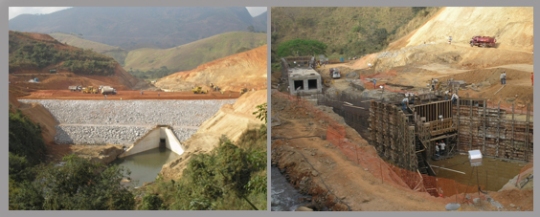Brazil’s leap into better energy supply
New power plant, to be in place and operational before 2014
Nicknamed “The Marvelous City,” Rio de Janeiro is the gateway to Brazil. And soon over 7-million spectators will arrive for the highly anticipated 2014 World Cup and 2016 Summer Olympics. The world will watch as Rio becomes the first city to host the Olympic games in South America and only the second to ever host both events back to back. There is however growing concern that the Olympic torch will be the only thing illuminating the night sky. That’s because Rio has repeatedly fallen victim to some of the worst power failures in history. So the Brazilian government has launched an ambitious plan to remove the entire city from the nation’s aging power grid and transform Rio into a self-sufficient ‘power island.’ The plan includes re-linking over 160 km of power lines, building the largest nuclear generator in the country, and the lynchpin: the Simplício Hydroelectric Complex.
This is one the of largest construction sites in the world, spanning an incredible 24 km. Crews are racing to divert over 780-billion gallons of water from the Paraiba do Sul River through some of the world’s widest tunnels. Once operational, this hydroelectric facility will help to generate nearly 30% more power for Rio. But with January storms threatening to dump over a foot of rain on their progress, crews must prepare for the messy and dangerous road ahead.
The project is a joint venture between Odebrecht Energy (leader) and Andrade Gutierrez. The project, contracted by Eletrobras (Furnas Centrais Elétricas S.A.), encompasses the towns of Três Rios and Sapucaia (Rio de Janeiro), Além Paraíba and Chiador (Minas Gerais) and includes a concrete dam in Anta, and two energy houses separated by a hydraulic circuit formed by channels, dikes and tunnels. When finished the Complex will have a production capacity of 333.7 MW.
The decision to re-route the river (as opposed to creating a reservoir, by flooding upstream) was in the interest of minimizing the project’s social and environmental impact on the region.
According to Fernando Chein, Contract Director, the construction of the Anta dam with Rolled Compacted Concrete is a major advantage:
“The system presents advantages such as speed in finishing the project and in the reduction, by half, in the use of cement by cubic meter of concrete”.
Seven of the Widest Tunnels in the World
Countless waterfalls and rapids make the Paraiba do Sul one of the wildest rivers in Brazil. To accommodate its torrent, each of the 7 diversion tunnels on the Simplício Hydroelectric Project must measure over 50 m in circumference. But there isn’t a Tunnel Boring Machine (TBM) on the planet that large. So workers must rely on a far more dangerous method of tunneling — heavy-duty jumbo drills and dynamite.
One of the Biggest Construction Sites in the World
The Simplício Hydroelectric Complex spans over 24 km, making it one of the biggest construction sites on Earth. Not only is this project larger than Manhattan Island, it’s also equipped with a city-like infrastructure complete with 5 medical centers, 4 data/voice towers, 6 cafeterias, 3 concrete plants, and a fleet of 70 cars and buses.
One of the Largest Earth-Moving Projects in the World
If a dam is constructed directly on the Paraiba do Sul River the reservoir it creates will flood the nearby town of Sapucaia. Rather than displace 130,000 people, engineers are diverting the river for a stretch of 24 km through 7 different mountains and 13 man-made channels. To pull off a job of this size workers must use over 600 different earth-moving vehicles. The contractors are utilising a an innovative construction method for the Civil works called hydroseeding, in order to stabilise the slopes.
Longest Power Transmission Link Ever Built
Approximately 90% of Brazil’s power comes from hydroelectricity. And because most of the country’s water is located in the Amazon rainforest, an extensive power grid is needed to connect remote hydroelectric outposts with major coastal cities like Rio de Janeiro. The latest addition to this grid will extend an unprecedented 2,400 km, making it the longest power transmission link in the world.
3 Giant Turbines
The Francis turbine is the most widely used hydro turbine on the planet. Here at Simplício, 3 of them will be in use, each capable of generating 102 megawatts of power. But the real benefit to the Francis turbine is adaptability. The erratic flow of the Paraiba do Sul creates a major obstacle for this project because drastic changes in water pressure at a hydroelectric plant either hamper energy production or completely destroy the turbines. The Francis turbine however has a revolutionary design that accommodates heads ranging anywhere from 9 m to upwards of 30 m.
Most Powerful Hydroelectric Plant in the World
The Itaipu Dam is Brazil’s greatest source of energy and home to one of the biggest hydroelectric complexes in the world. It is located in the south of Brazil, near the Foz do Iguaçu waterfalls on the border with Argentina and Paraguay. In 2008 the plant generated a record 94.68-billion kilowatt-hours. That’s over 10-billion kilowatt-hours more than Three Gorges Dam! Here, maintenance is paramount since Itaipu supplies 20% of the energy consumed by Brazil and 90% of that consumed by Paraguay.
Related Articles
- Eletrobras to Raise $4 Billion as Debt Costs Fall (businessweek.com)
- Cogentrix Energy Places Turkey Hydroelectric Generating Plant into Operation (eon.businesswire.com)




